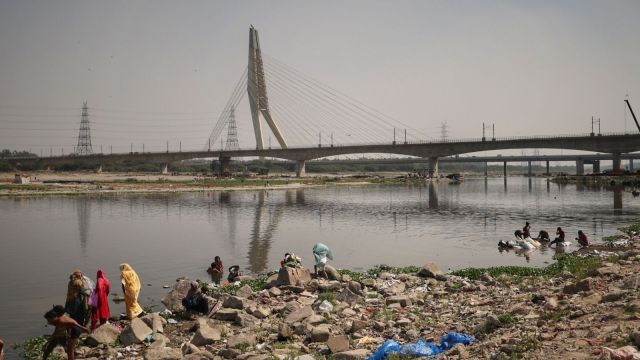Strawberry farms, sailing clubs and cricket grounds: A journey along the Yamuna in Delhi
For farmers, boatmen and several others who live along the Yamuna, the river, despite being highly polluted, remains their lifeline. With the river being front and centre in the recent Delhi polls, and promises being made to clean it up, The Indian Express speaks to the inhabitants of the river banks on what it means to them
 The Yamuna river at Sur Ghat. The water quality analysis by the Delhi Pollution Control Committee in February shows that the Dissolved Oxygen (DO) levels became zero from the ISBT bridge until Asgarpur where the river exits Delhi. (Express Photo by Tashi Tobgyal)
The Yamuna river at Sur Ghat. The water quality analysis by the Delhi Pollution Control Committee in February shows that the Dissolved Oxygen (DO) levels became zero from the ISBT bridge until Asgarpur where the river exits Delhi. (Express Photo by Tashi Tobgyal)Every few months, the Yamuna is blanketed in a layer of white foam, so thick that it resembles puffy cumulus clouds — but this is no ordinary foam, it is a toxic cocktail of industrial waste and untreated sewage. This is the sight the people of Delhi most associate the river with.
Several political parties, from the Aam Aadmi Party to the Bharatiya Janata Party, have promised to restore the river to its once pristine condition over the years. The issue became a political hot potato in the run-up to the Delhi Assembly elections, with the river featuring prominently among poll promises of each party.
Away from the media glare, what does the river mean to the residents living along its banks — farmers, boatmen, washermen and fishermen — whose livelihoods it sustains?
The Indian Express travels from Palla, where the Yamuna enters the city from Haryana, to Okhla where it flows into Uttar Pradesh, to find answers.
Palla to Wazirabad
Sitting on the river’s eastern bank, the village of Palla is at the intersection of Delhi, Haryana and Uttar Pradesh — it is also the point where the Yamuna trickles into the national capital. Along the banks, the rolling fields are full of wheat, strawberries, watermelon and muskmelon, and rows of marigolds.

In January, the slow life of the village was interrupted when former Delhi Chief Minister and AAP chief Arvind Kejriwal accused Haryana of poisoning the water and Haryana Chief Minister Nayab Singh Saini visited Palla and took a sip directly from the Yamuna to disprove the claims.
Data shows the river is at its cleanest in this stretch. The Dissolved Oxygen level, “which indicates whether the river is alive or not”, is 6 mg/litre at Palla and 5.3 mg/litre at Wazirabad, according to government data from February. The ideal DO in the river stream is 5 mg/litre. It becomes 0 after the Wazirabad Barrage.
The farmers, though, don’t use the river water for their fields.
“It is very dirty here too,” says Pawan Dhiran, 25, who is growing spring onion and wheat on his land. “Haryana allows sewage to flow into the river… everyone here uses water from their borewells.”
His friend, Neeraj Kaushik, 26, adds, “Agar nadi ka paani seedha daale toh keede lag jaaye humare kheto mein… peeche se saari factoriyan, naale isme hi gandagi chhodti hai (If we use river water directly, then pests would invade our fields…)”
What helps is the soil; it is sandy, has high moisture levels, and is suitable for these crops.

Villagers recount a time, as recently as six-seven years ago, when they could bathe in the river. Now, no one does. “Ek toh pani saaf na hai, dusra ret mafia bohut ret churata hai nadi se, usse bade bade gaddhe ban jaate hai jo kisi ko pata nahi kaha hai. Usme bohut log fisal jaate hai. (Firstly, the water is not that clean. Secondly, the sand mafia steals a lot of sand from the river. This creates huge holes that no one knows the location of, causing people to slip),” says Shrawan Kumar, 39, Dhiran’s cousin.
Despite its polluted state, the Yamuna is revered. “Nadi se logo ka atmiye judhav hai (People are connected to the river spiritually),” says the priest of Prachin Jamuna Mai Mandir.
Dhiran also says interaction with the river is minimal throughout the year, but during festive occasions, such as Ganesh Chaturthi and Chhath Puja, people offer prayers to the river. “Yeh nadi humari mokshdham bhi hai (It is our final resting place),” he says.
There is a pyre next to the temple.
Right now, there is barely any water in the river. But behind the temple is a pool where around 20 buffaloes frolic even as their owner tries to get them out. “Pura din motor ke paani mein sukh nahi hai, ek ghanta yamuna maiya mein zyada sukh ha inko (They like spending one hour in the Yamuna more than spending the whole day in water from the motor),” chuckles Ramlal Yadav, 40, who, along with his three brothers, owns more than 100 buffaloes.

In the monsoon months of July and August, the river swells. Once, every two-three years, it rises so much that it submerges all surrounding farms. “But once the water recedes, it leaves behind rich mineral content on the floodplains, which make the soil extremely productive,” says Amit Saini, 34, the owner of Parbhat Nursery.
As one travels downstream towards Wazirabad, a more urban and dense Burari takes over. Debris and garbage too make an appearance.
A little further ahead, on the Western Bank, is a surprising sight — children of all ages are either seen exercising or heading towards the water with kayaks in hand.
This is the Sonia Vihar Water Sports Club Society. Its coach Manjeet Shekhawat proudly lists their achievements: Asian and National champions have come out of this club, while 40 of its students have been selected for government jobs.
“We run completely on contributions by people from Sonia Vihar; we don’t receive any money from the government,” he says. Shekhawat doesn’t get paid to coach the students either; he relies on a government school job, after which he comes and teaches at the club.

“Most children are from nearby areas in East Delhi such as Sonia Vihar, Khajuri Khas and Burari, as not a lot of people know about this club,” Shekhawat says.
The club’s functioning is entirely dependent on the river. In May and June, the river completely dries up, and in July and August, there’s too much water flowing for kayaking. During these four months, students undergo endurance and strength training. The rest of the year, the water is five- to six-feet deep, perfect for all kinds of water sports.
A couple of kilometres upstream, Lalu Saini, 45, a fisherman, is getting ready to call it a day when a woman, along with her two daughters, requests him to transport them across the river; they have to break their roza. He acquiesces.
Saini is up at 3 am every day and wraps up fishing by around 9 am. After that, he transports people to and fro the river; when he doesn’t get passengers to ferry across, he finds a cool place on the bank and takes a nap.
“Dussehra is a good time for us, we can catch 30-40 kg of fish a day, which we sell for Rs 150 per kg. The winter months are really bad. On bad days, I get a haul of 2-2.5 kg,” Saini, a resident of Chauhan Patti, says.
Saini has been fishing for as long as he can remember; his entire community practises fishing. “The last few months have been extremely bad. After the BJP came to power, the water has become cleaner,” he adds.
Wazirabad to ITO
Standing by the river’s edge at Sonia Vihar, 65-year-old Susheela Devi recalls the days when she would take a bath in the Yamuna regularly. Now, she hesitates even to dip her fingers. Dropping flowers into the water, she admits, “It is the people’s fault… Broken idols, frames, puja items — we leave it all here. The sacredness that brings us here also pollutes the banks…”
She wishes for a well-maintained ghat, a space where faith and cleanliness co-exist. But most of all, she wishes to trust the water again. “Ek tho dar lagta hein nahaane ka ki kaha gehra ho… Aise ghatna hothi rehthi hain. (I fear not knowing where the water is deep. Accidents keep happening here) The water starts to become black… still many bathe,” adds Devi.

This 12-km stretch between Wazirabad and the ITO barrage is home to several ghats. This is also the point where the Najafgarh drain mixes with the river.
A water quality analysis by the Delhi Pollution Control Committee in February shows that the Dissolved Oxygen (DO) levels became zero from the ISBT bridge until Asgarpur where the river exits Delhi. Two per cent of the 1,376 km-long river flows in Delhi and yet, it contributes to 97% of the pollution load, according to government records.
Narayan Kumar, 36, a regular visitor who comes with wheat flour balls to feed the fish, knows the river is sick. “Yaha peh tassali hain…”
Near Vasudev Ghat, Bobby Khurana, 46, watches the river water swirl. An electrician from Bhalswa, he comes here daily out of faith. “Can this river ever be revived?” he wonders aloud.
He remembers when migratory birds flocked in large numbers on the bankside. “It hurts to see how the birds and fishes are affected because of what is done to the river…,” he says.
Further downstream, at Nigambodh Ghat, Sarla, a 70-year-old from a family of boatmen, drinks the river water every day. “It is this river that has made our lives possible,” she says with unshaken faith.
Ganesh, 39, who does pre-wedding shoots at the same riverside, remembers his childhood. “I used to swim here,” he says. “Now the fish are dying, and crores of rupees have been wasted by every government — Congress, AAP, BJP. Nothing has changed.” He blames the unregulated flow of drains that outfall into the Yamuna to be the cause of the pollution. “Stop them, and maybe we can save this river.”

There is a unique economy here, with vendors selling puja items and priests dotting this side of the banks. Manju Devi, 35, who is threading flowers into garlands, says she has been at the Yamuna Ghat for two decades. Business was better once. “People don’t come like before,” she says. “For four or five years now, the crowd has thinned. After Covid, people barely returned.” Satyanarayan Pandit, 42, is a boatman and swimming coach who built his life on this river. After pulling a boat ashore at the ghat, he says, “But now, the number of visitors has dropped so much that I had to find another job.” He now works part-time as a swimming coach at Crowne Plaza.
At the Yamuna Bazaar side are a handful of dhobis drying white clothes spread widely near the river bank. One of them says, “Our family has been doing this for generations. Now we are afraid we will soon have to stop this, authorities have asked us to move out. But, we still stay because we have nowhere else to go.”
Somvati, 70, sitting in a jhuggi at Yamuna Khadar Shastri Park says, “This place used to be full of fields and flowers,” she sighs. “Now? Just filth. It has changed too much in the past year.”
Her daughter-in-law, gathering spinach from the fields, says, “The officers have planted trees here… We cannot do farming here the way we used to anymore.” She is referring to the Delhi Development Authority’s Asita Biodiversity Park spanning 197 hectares.
On the eastern side, under the old ITO Bridge — the stench is stronger here — are hundreds of migrants living in fear of eviction. Sumitra, a 30-year-old, who is a temple caretaker, says, “Today, we got a notice. We have five days to vacate…”
Recently, islands were made by the Irrigation and Flood Control Department to prevent floods. Aisha Khatur, 30, recalling the flood days, says, “Only when there is a flood the government remembers us. Otherwise, we are neglected. There is no security here, especially for women.”

Kharun Nisha echoes her. “We don’t use this water for utensils or bathing anymore. It’s too dirty.” Her child laughs, remembering an old man who once drank two glassfuls of Yamuna water without hesitation. “He said it was pure. Imagine that now.”
Standing opposite the bank at Chhath Ghat is Zakir, 24 who has spent most of his life by the river. “I’ve been here since I was 11. If someone drowns, we rescue them.” He recalls his childhood when the water was still clear enough to drink. “From around 2006, everything changed.”
Machines now frequent the banks, he says, meant to clean the river. “Maybe they will help. Maybe they will give people employment.”
ITO to Okhla Barrage
Down the ITO barrage, the land abutting the river on the eastern bank is low-lying. Stretching across are fields with a variety of spinach, bitter gourd, and broad beans being cultivated. Rows of marigolds sway in the breeze.
But this section is even more polluted with untreated sewage mixed with industrial waste. In the upstream portions, puja offerings, agricultural runoff, and household discharges contribute to the contamination.
In 2015, the National Green Tribunal banned farming along the Yamuna floodplains due to contamination. A 2016 order rejected requests to permit agriculture, citing risks of heavy metals entering the food chain.

Yet, for those living along the banks, farming is the only means of livelihood. Alongside the issue of pollution, the more pressing concern remains the threat of eviction
Bolting across his 9-bigha field — rented by his family— as a cow charges forward to feed on red spinach (chaulai) leaves, Maharam Singh Maurya (22) says, “During the election, we voted for Ravinder Singh Negi (BJP Patparganj candidate and now MLA) because he promised us he would not allow the jhuggis to be demolished.”
A few bighas away at the Yamuna Khadar are more farmers, mainly from Uttar Pradesh and Bihar. They have settled in jhuggis, cultivating vegetables throughout the year. Among them is Lekhram Choudhary, 57, who has spread out his farm produce for the day — broad beans or bakla. But he is from the mallah community, he says. Belonging to the Scheduled Caste, they are known to be traditional boatmen, and some are also coin divers.
“There is now a fifth generation of mallahs here… coexisting with Jamuna.” However, there are no fisherfolk as the river is highly polluted, says Choudhary.
From Wazirabad to Okhla, the Yamuna receives no fresh water. The Okhla Barrage, managed by the Uttar Pradesh Irrigation Department, is notorious for its foamy white froth — formed by phosphates and surfactants from untreated sewage — that floats on the water, especially during the onset of winter. According to data from the Delhi Pollution Control Committee, in February, faecal coliform levels at Okhla Barrage were 1,840 times the desirable limit, measuring 9,20,000 MPN/100 ml. Similarly, the Biochemical Oxygen Demand (BOD) was 13 times the permissible limit, at 39 mg/l. Another parameter, Chemical Oxygen Demand (COD), an indicator of organic matter decomposition, was 89 mg/l.
Near the Yamuna Khadar are also six cricket grounds. They have the essentials: a pitch and a team pavilion made out of bamboo. “People come to play here on the weekend,” said a player who refused to be named.
“During the 2023 Delhi floods, water submerged all these cricket grounds. And when the water receded, huge piles of sand covered this entire area,” he adds.
Across the river in Jamia Nagar, Raies Ahmed, 50, toils at the Dhobi Ghat near Sailing Club Road in Okhla. Once a thriving hub with nearly a thousand washermen, the community now is largely depleted — the pandemic and ongoing evictions have reduced their numbers to just five. “Authorities have given us notice to vacate, but we’ve requested time due to Eid,” says Ahmed.
Next to where Ahmed stands amidst lush riverine grasslands from where the river is only a tip-toe away, Shabnam, 40, with a herding stick in hand, waits for her goats to graze on the grass. “The jhuggis here were demolished in 2019 during the CAA-NRC protests,” she says, watching a construction site where her home once stood.
“We bathed in the river last when the river flooded in 2023. We had to shift our jhuggis to the road…” “But all of us got the chance to take a dip in the river,” she adds sarcastically.
Near the Dhobi Ghat are two sailing clubs: a Defence Services Sailing Club and Delhi Naval Unit NCC. “We train NCC cadets here in boating and kayaking before national and international competitions,” says an NCC personnel.
Despite its polluted state, this dying river remains a lifeline to many like Rita Devi, 37, who earns her livelihood by collecting and selling produce from the riverine grasslands.
“Jamuna ke kinaare reh rahe hein tabi pass se la rahe hein sarr se laate hein road se parr kar ke phir pul ke nichhe giraathe hein. Iske kaaran hi toh kaathe peete kamathe hein… (We live next to the Yamuna; that is why I can collect this daily and transport it easily. It is because of the river that we eat, earn and live.”)
Must Read



Buzzing Now
Apr 08: Latest News
- 01
- 02
- 03
- 04
- 05























